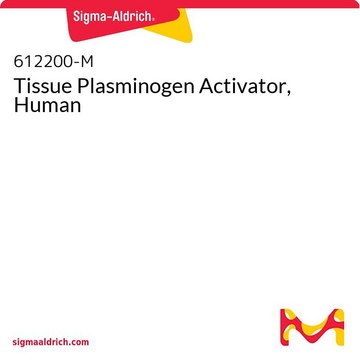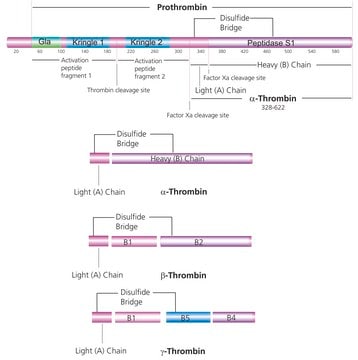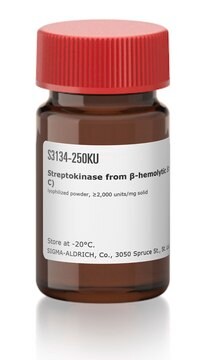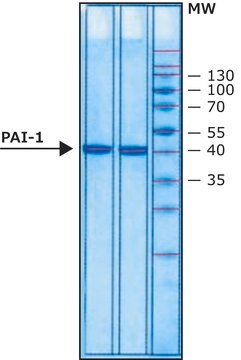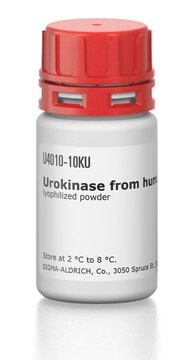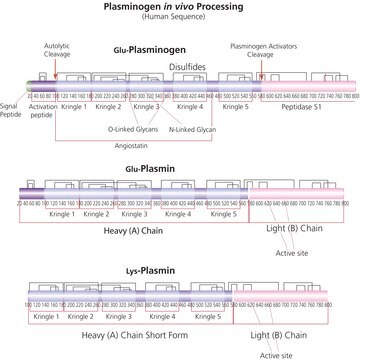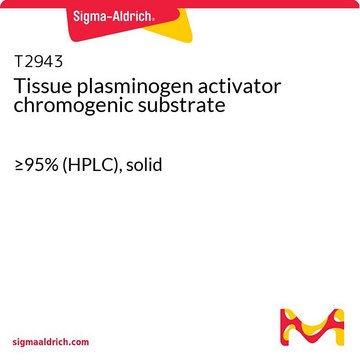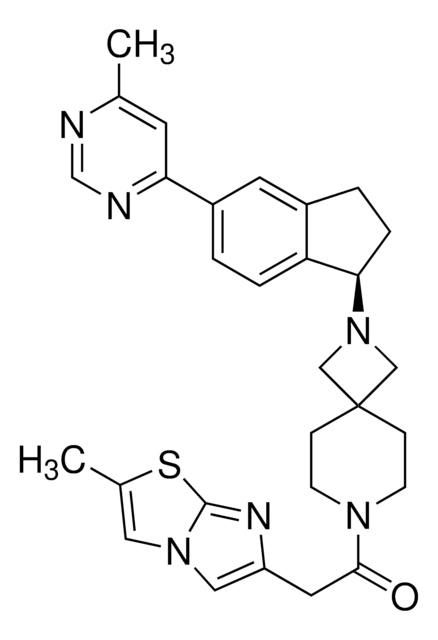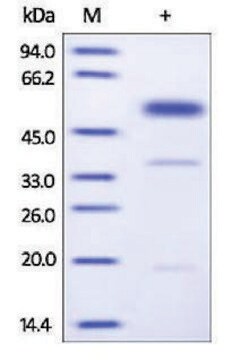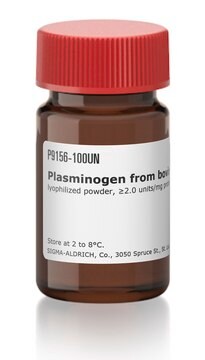T0831
Tissue plasminogen activator human
Sinônimo(s):
tPA
Faça loginpara ver os preços organizacionais e de contrato
About This Item
Número MDL:
Código UNSPSC:
12352204
NACRES:
NA.54
Produtos recomendados
Formulário
lyophilized powder
Nível de qualidade
atividade específica
≥300 KU/mg protein
peso molecular
~70 kDa
Impurezas
HIV, HCV, and HBsAg, tested negative
nº de adesão UniProt
Condições de expedição
wet ice
temperatura de armazenamento
−20°C
Informações sobre genes
human ... PLAT(5327)
Procurando produtos similares? Visita Guia de comparação de produtos
Descrição geral
Tissue plasminogen activator (tPA) is a protease of the S1 family (trypsin family) and is found in a wide variety of mammalian tissues, especially endothelial cells. tPA is secreted as a single chain precursor, which is cleaved to a two-chain form by plasmin. Supplied in the single chain form with a molecular weight of ~70 kDa. The Tissue Plasminogen Activator (tPA) gene is mapped to human chromosome 8p11.21 and encodes a protease of 69 kDa majorly containing serine amino acid residue. It is predominantly expressed in endothelial cells.
Aplicação
Tissue plasminogen activator has been used in a study to assess treatment risks of intracranial hemorrhage among patients with acute ischemic stroke. Tissue plasminogen activator has also been used in a study to investigate the successful treatment of early thrombosis of HeartWare left ventricular assist devices with intraventricular thrombolytics. Human tissue plasminogen activator has been used to study the effect of tyrosinase-related protein 2 (TRP-2) expression on melanin production in sheep.
Ações bioquímicas/fisiológicas
tPA is a potent activator of fibrinolysis and converts plasminogen into plasmin and also initiates cell signaling. The plasminogen activation system may also be associated with degradation of amyloid fibrils. It is also known to mediate inflammatory and extracellular matrix remodeling processes and is predicted to participate in disease progression of intracranial aneurysm indicating brain vascular malformations. Upregulation of the gene is observed in aortic aneurysms.
forma física
Lyophilized powder, from 100 mM PBS (pH 7.4), 3.5 mg/mL L-arginine, and 0.001% Tween® 80
Nota de preparo
Reconstitute with dH2O to a final concentration of 1 mg/mL (e.g. 100 μg should be reconstituted in 100 μL).
Informações legais
TWEEN is a registered trademark of Croda International PLC
Palavra indicadora
Warning
Frases de perigo
Declarações de precaução
Classificações de perigo
Eye Irrit. 2 - Skin Irrit. 2 - STOT SE 3
Órgãos-alvo
Respiratory system
Código de classe de armazenamento
11 - Combustible Solids
Classe de risco de água (WGK)
WGK 3
Ponto de fulgor (°F)
Not applicable
Ponto de fulgor (°C)
Not applicable
Escolha uma das versões mais recentes:
Já possui este produto?
Encontre a documentação dos produtos que você adquiriu recentemente na biblioteca de documentos.
Os clientes também visualizaram
Converting Tissue Type Plasminogen Activator into a Zymogen IMPORTANT ROLE OF Lys156.
Tachias K and Madison E L
The Journal of Biological Chemistry, 272(1), 28-31 (1997)
Design, synthesis, and characterization of urokinase plasminogen-activator-sensitive near-infrared reporter.
Law B, et al.
Chemistry & Biology, 11(1), 99-106 (2004)
Successful treatment of early thrombosis of HeartWare left ventricular assist device with intraventricular thrombolytics.
Kamouh A, et al.
The Annals of Thoracic Surgery, 94(1), 281-283 (2012)
Differential expression assay of chromosome arm 8p genes identifies Frizzled-related (FRP1/FRZB) and Fibroblast Growth Factor Receptor 1 (FGFR1) as candidate breast cancer genes.
Ugolini F, et al.
Oncogene, 18(10), 1903-1903 (1999)
Amorphous protein aggregates stimulate plasminogen activation, leading to release of cytotoxic fragments that are clients for extracellular chaperones.
Constantinescu P, et al.
The Journal of Biological Chemistry (2017)
Nossa equipe de cientistas tem experiência em todas as áreas de pesquisa, incluindo Life Sciences, ciência de materiais, síntese química, cromatografia, química analítica e muitas outras.
Entre em contato com a assistência técnica